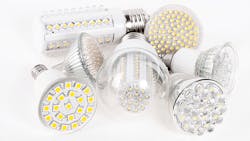Are LED Light Bulbs Ready for Industry and Consumers?
Definitely. You’ll notice whenever you visit any home improvement store or department that LED light bulbs are taking over the shelves that used to be filled with incandescent and compact fluorescent bulbs.
What are the benefits of LED lighting to industry?
Two of the major benefits are energy efficiency and longevity. Other benefits include durability and design flexibility. Additionally, LED lights are eco-friendly; they are free of toxic materials, like mercury, which is found in fluorescent bulbs.
How long can a business/consumer expect the average LED to last? Are they good in all weather/environments?
A typical lifetime listed by many manufacturers is 50,000 hours. There are LED luminaires designed for use in extreme outdoor conditions where temperature extremes, as well as exposure to rain, snow, and UV light from the sun, can be a challenge.
Any idea of the payback period for LEDs? In other words, how long does a person or business have to use an LED to save enough money over conventional bulbs to make up for the difference in cost between conventional bulbs and LEDs?
The payback period depends on a number of factors, including the cost of the bulb or fixture, the savings in cost of electricity, and the frequency of use. Payback periods are typically somewhere between two and five years.
This file type includes high resolution graphics and schematics when applicable.
Are LEDs safe? Are there any problems with overheating, EMF, or hazardous materials for recycling?
LEDs are safe, but with any electronic product it is critical that the overall design meets the proper safety standards.
Are there any downsides to LEDs?
The main downside is the initial cost, but prices continue to drop, making it more attractive to make the switchover. And although LEDs excel in cold environments, like coolers or freezers, they struggle in high-temperature conditions, such as those found inside industrial or commercial ovens. LED lifetimes are significantly shorter in higher temperatures, and materials used ... have limitations compared to the glass, metals, and ceramics used to make incandescent bulbs.
How far will costs for LED bulbs drop?
Costs have dropped significantly over the past few years. I expect that prices may continue to drop, but it is believed that the bigger changes will be increases in efficiency.
Are all LEDs on the market of good quality? How can a business or consumer tell the difference between good ones and the not-so-good ones?
Not all LEDs are high quality, but even with high-quality LEDs, overall fixture design is important. One key task of the fixture design is to keep the LED temperature within specifications.
Other design considerations to take into account depend on the end application of the LED fixture. The requirements are much different for an LED light intended for a clean, dry environment, like an assembly station, as compared to a light for a CNC machining center that is regularly exposed to water or oil-based coolants. Having the proper approvals, like CE and UL, verify the design meets performance and safety requirements, but this doesn’t always mean that the light will last a long time.
Are any technological changes/upgrades coming to LEDs? If so, what is pushing them and what benefits will they bring?
LEDs are continually evolving. The efficiencies (lumens/watt) are increasing and the costs are continuing to decrease. There is a lot of competition among LED manufacturers to continue outdoing one another, which is great for luminaire manufacturers, because it gives them more choices and allows them to offer brighter and more efficient products.
Where are most LEDs made? Any chance LED manufacturing will come to the U.S.?
There is still a lot of the LED die being manufactured in the U.S., but for the most part, the packaging of the die into the final LED is done in Asia ... there is no reason to expect that to change


